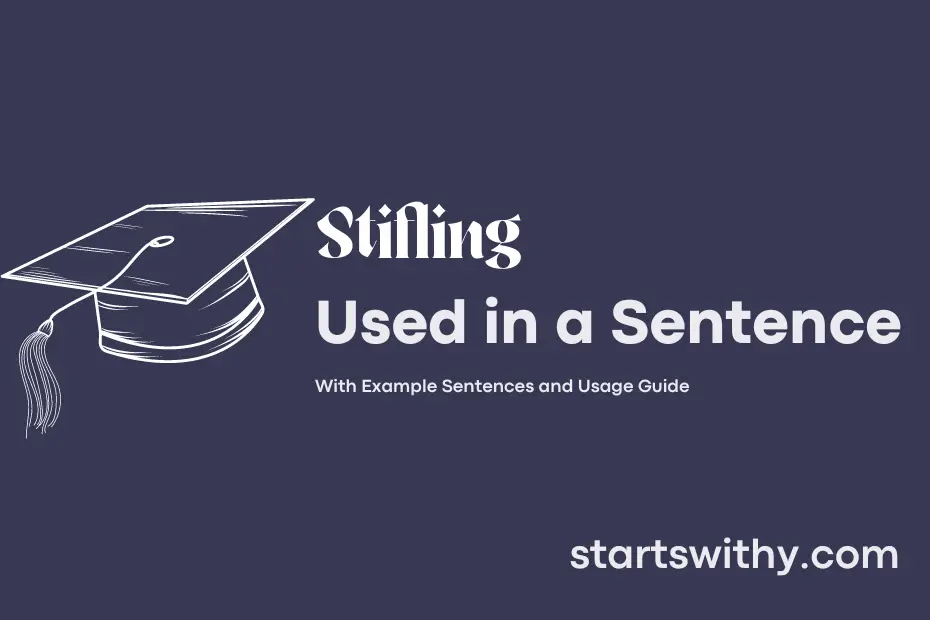Have you ever felt the suffocating effects of stifling heat on a scorching summer day? To be stifling means to smother or oppress with heat, lack of air, or an overpowering force. It’s that feeling of being trapped or held back, unable to move or breathe freely.
In writing, a stifling sentence can similarly weigh down your prose, making it feel heavy and difficult to digest. Keeping your sentences clear and concise without overwhelming your readers with excessive details is key to avoiding a stifling effect in your writing. Let’s explore how to craft sentences that flow smoothly and keep your readers engaged.
7 Examples Of Stifling Used In a Sentence For Kids
- The stifling heat made us all feel very hot and sweaty.
- Let’s open the windows to get some fresh air in this stifling room.
- I don’t like wearing heavy clothes in this stifling weather.
- The stifling smell of the garbage made me cover my nose.
- We need to turn on the fan to cool down in this stifling heat.
- It’s important to stay hydrated in this stifling weather.
- The classroom felt stifling without any ventilation.
14 Sentences with Stifling Examples
- It’s stifling to study in a crowded library without proper ventilation.
- The stifling heat in the classroom makes it difficult to concentrate during lectures.
- Wearing a mask for long hours in the stifling heat can be uncomfortable for students.
- The stifling rules and regulations of the college often hinder students’ creativity.
- The stifling pressure to excel in exams can take a toll on students’ mental health.
- The stifling atmosphere of competitiveness among peers can lead to unhealthy rivalries.
- The lack of opportunities for open discussions can create a stifling academic environment.
- The stifling workload of assignments and projects can leave students feeling overwhelmed.
- The strict dress code imposed by the college can be seen as stifling by the students.
- The stifling tradition of blindly following what textbooks say without questioning can hinder critical thinking skills.
- The stifling hierarchy within student organizations can discourage new ideas and innovation.
- Students often feel stifled by societal expectations to pursue traditional career paths.
- The stifling peer pressure to conform to a certain lifestyle can lead students astray.
- The lack of representation and diversity in the curriculum can create a stifling learning environment for students.
How To Use Stifling in Sentences?
To use the word Stifling correctly in a sentence, keep in mind that this word is typically used to describe something that is suffocating, oppressive, or overwhelming.
Here are some examples of how you can incorporate stifling into a sentence:
- The stifling heat of the small room made it difficult to concentrate.
- She felt a stifling sense of anxiety as she waited for the test results.
- The stifling rules and regulations at work made it hard for creativity to thrive.
- The lack of fresh air in the crowded subway was stifling.
- His stifling fear of failure held him back from pursuing his dreams.
Remember, when using the word stifling, try to convey a sense of oppression, discomfort, or restriction in your sentence. By doing so, you will effectively communicate the feeling of being overwhelmed or suffocated.
Practice incorporating stifling into your everyday conversations or writing to become more comfortable using this word in various contexts.
Conclusion
In conclusion, the various examples of sentences with “stifling” illustrate how something oppressive, suffocating, or limiting can impact different aspects of life. These sentences highlight the feeling of being held back or restrained, whether it’s by physical discomfort, emotional suppression, restrictive rules, or oppressive environments. Through these examples, we can see how the word “stifling” effectively conveys a sense of confinement and restriction that can hinder growth, creativity, and well-being.
Overall, the use of “stifling” in sentences serves as a powerful reminder of the impact that restrictive conditions or environments can have on individuals. By recognizing and addressing these stifling factors, whether in personal relationships, work settings, or societal norms, we can strive to create spaces that foster freedom, innovation, and personal fulfillment.



